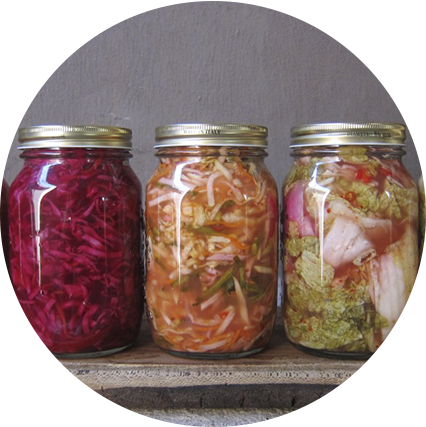FERMENTED FOOD
FERMENTING NOT ONLY PRESERVES FOOD BUT ALSO ENHANCES THE NUTRIENT CONTENT. THE ACTION OF THE CULTURE ORGANISMS MAKES THE MINERALS IN CULTURED FOODS MORE READILY AVAILABLE TO THE BODY. DURING THE FERMENTING PROCESS THE BACTERIA ALSO PRODUCE B VITAMINS AND ENZYMES THAT ARE BENEFICIAL FOR DIGESTION.
Culturing or fermenting a food involves the chemical process of breaking a complicated substance down into simpler parts, usually with the help of bacteria, yeasts, or fungi. Fermented food is considered a live food and the culturing process continues during storage to enhance the food’s nutrient content. All cultured vegetables have a natural tart flavor as the sugars and carbohydrates have been broken down and used up in the process. The lactic acid also contributes to the tartness of fermented foods. Cultured vegetables are a great option for low-carbohydrate diets.
Almost any vegetable can be fermented. Fermenting local, farm-fresh produce is a great way to provide good nutrition year-round. You can ferment just one vegetable or a mix of many different kinds. A tantalizing mixture is beets with carrots, ginger, garlic, leeks, onions, dulse (seaweed), and jalapeños. Kimchi recipes include cabbage, red chili peppers, garlic, ginger, and onion. Pickles can be spiced with dill and garlic; sauerkrauts can include juniper berries, caraway seeds, and more.
SAUERKRAUT
2 green cabbage heads, finely shredded
2 large onions, julienned
3 teaspoons of sea salt
1 cup filtered water
1 cup of lemon juice or 1/2 cup of apple cider vinegar
2 Tbs seaweed such as wakame, kelp or dulse (optional)
*Additional flavor options hot peppers, carrots, beets, fresh herbs, radish, curry powder, ginger and garlic.
Method
Toss cabbage and salt together in a large mixing bowl, knead the cabbage and salt thoroughly to break up the cellular structure of the shredded cabbage. Add onion and lemon juice. When the cabbage has become limp and releases its juice, transfer it to mason jars or vegetable fermenter (available here).
Pack the cabbage into the container until the cabbage is completely submerged by liquid. Make sure to pack it as tightly as you can, eliminating air bubbles. Cover loosely and allow it to sit at room temperature, undisturbed, for at least 1 month. The longer it ferments the more potent the flavor. You can let it sit for up to 6 months, testing the sauerkraut every few. Transfer to the refrigerator where it should keep for at least 6 months to a 1 year.


